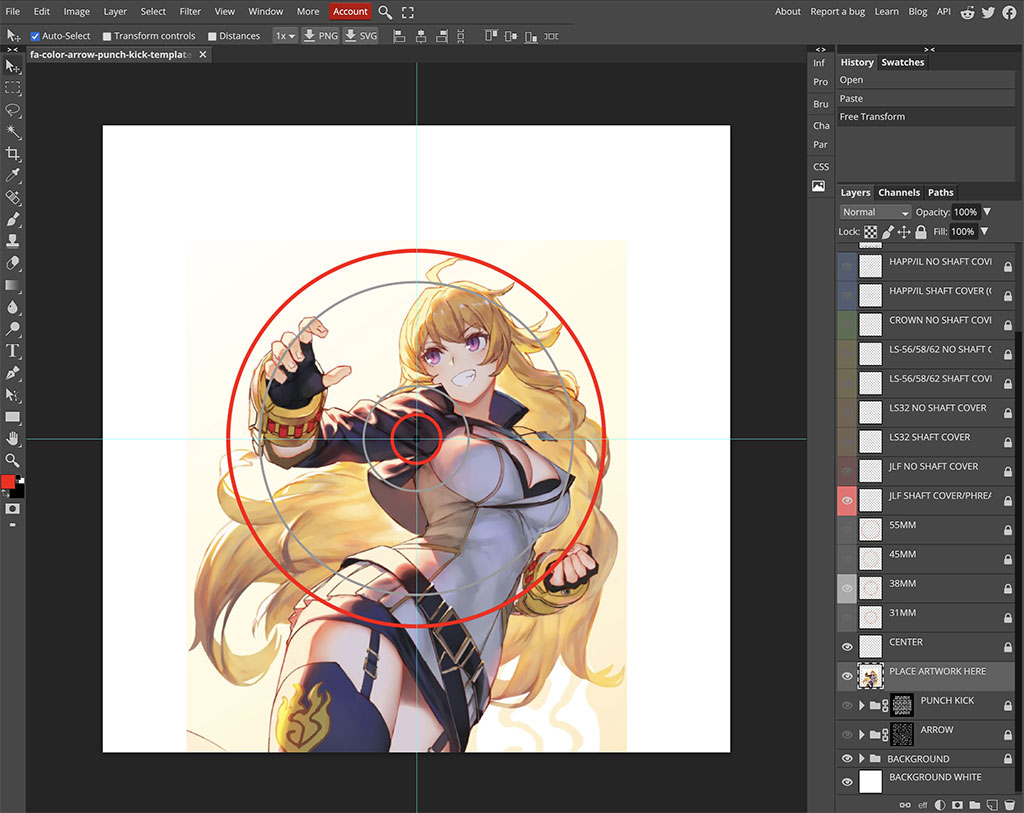- Category
- What's New?
- FightSticks/Pads
- Joysticks
- Pushbuttons
- Spare Parts & Tools
- Hardware & PCB
- Electrical
- Customize
- Merchandise
- Sales & Clearance
- Brand
Qanba Obsidian 2 Stickless Custom Art/Plexi Bundle
Choose Your Options
-
Product Description
Bundle Does not include Actual Fightstick
Please note that the Custom Art/Plexi Bundle only contains parts that complement the commercial Fightstick it is designed for. It does not include the Fightstick - this is purchased separately from Amazon, eBay or another vendor.
The fighting game community has enthusiastically embraced all-button - a unique arcade input control method that replaces the up, down, left and right directions with pushbuttons instead of a joystick lever. Thanks in part to AllFightSticks - makers of incredibly durable steel FightStick enclosures - you can now own a stick-less version of your favorite model.
Save Over Purchasing Separately
This discounted bundle includes your replacement panel, plus custom artwork print, and blank plexi. Finally, you'll score special bonus items such as the Buttercade SnapOuts for 24mm and 30mm.
- AFS Qanba Obsidian/Obsidian 2/Crystal Replacement Panel - Stickless Layout ($34.95 Value)
- Stickless Replacement Plexi ($16.95 Value)
- Buttercade SnapOut Button Tools: 30mm and 24mm ($15.95 Value)
- Custom Printed Artwork ($14.95 Value)
- FA SO.CD Cleaner for All-Button Control v2 ($17.95 value)
- All-Button Harness for FA SO.CD ($3.95 value)
- Power Passthrough Harness for FA SO.CD - Qanba Obsidian ($3.95 Value)
- Replacement Qanba Obsidian 1 Panel Screws - Set of 6 - Choice of Black or Stainless Steel ($1.25 value)
- Brillianize Instant Detailer Pack For Plexiglass ($1.95 Value)
- 3mm Hole Low Profile Adhesive PCB Feet (Set of 4) (95 cents value)
Designed for Qanba Obsidian 2
Obsidian 2 Stickless Panel Template
(Must use custom AFS metal panel replacement.
Not compatible with other Obsidian 2 stickless panel replacements - 1.8Mb zip)Install Notes


The original acrylic top panel has artwork permanently attached to it. To replace the original panel, you must first remove 6 black stickers on top panel and epoxy glue below those stickers across the top and bottom area of the panel. You can re-use the existing screws if you are able to remove the epoxy, or you can purchase replacement screws in silver and black oxide. To access the internal wiring, use a Phillips head-screwdriver to unscrew the 6 screws on the bottom panel. A screw is hidden behind a white warranty tamper sticker. The Obsidian 2 features a cover for the joystick shaft. Using a flathead screwdriver, place it between the shaft groove and then begin turning the balltop. This will allow you to unscrew a balltop or battop. 

Once the bottom panel is removed, make note of the button wiring. The guide shows the wire colors for each button when the panel is upside down, the orientation you are likely to have when installing the Stickless metal replacement panel.
Remove the terminal connectors from each button. Remove the 5-pin connector from the joystick lever as well.Screwbuttons such Sanwa OBSN, or Seimutsu PS-14-GN/KN will fit the Obsidian 2, as top buttons' proximity to the control PCB is not as close as the original Obsidian. That said, you may have varying results with screwbuttons fitting within the Stickless style layout. Also note that the slightly larger Seimitsu PS-14-G pushbuttons may have trouble fitting in this panel.
Shown here is the original top plexi panel removed. The top middle screw hole requires a longer screw, which we explain in the next step.
Note that the metal panel contains cut-outs around the button holes. Snapbuttons such as Sanwa OBSF will attach to the plexi panel, not the metal panel. The tab cutouts in the metal panel's holes will dictate which orientation your buttons install. Keep this in mind when installing artwork in the button insert cap, as it may need to rotate to match the button tab position when reinstalled.


With the Vewlix style panel removed, install the replacement AFS Stickless panel. Position the new panel into the shallow groove that the original panel occupied. Use the 6 silver screws from the original panel to attach the new panel to the Obsidian 2 housing.
Luckily, the Qanba team anticipated a Stickless replacement panel may one day arrive. They already pre-cut the bottom middle panel near the stickless' up button would appear.
Flip the Obsidian 2 upper case over to reveal the Fightstick motherboard. Connected to the motherboard is the USB power cable, along with the joystick lever connector. Both will connect to the FA SO.CD (included with our Obsidian 2 Stickless Bundle kit). As of this writing, there is no CPT certified firmware update for the Qanba Obsidian 2 (Q7), which is why the FA SO.CD is required. 

In this step, you will install the supplied Qanba passthrough harness (included with our Obsidian 2 Stickless Bundle kit) into the USB Power connector. First, as shown in steps 1 and 2, remove the existing USB power connector, located to the right of the 5-pin joystick lever harness. Next, connect the female end of the USB power connector harness to the male end of the passthrough harness. Finally, in step 4, attach the female end of the passthrough cable to the female end of the USB Power connector. The passthrough harness uses the electricity from the USB connector to supply power to the FA SO.CD.
Note that the connectors are keyed - there is only one way to insert them into the corresponding pins.We're now ready to connect the passthrough harness to the FA SO.CD. Attach the male 2-pin connector to the female connector on the SO.CD. This connector is also keyed and can insert only one way. If you notice difficulty inserting the pin, it's likely that you have it upside down and need to flip. 
At this stage in the process, you will now install your top artwork and acrylic panel. Use the included Set of 6 Bolts for Qanba Obsidian 2 Fightstick (if you purchased our Qanba Obsidian 2 Stickless Custom Art/Plexi Bundle) and take note of the slightly longer 1.5 inch screw in the set. This screw is longer to address the unique "half-screw" hole Qanba designed into the Obsidian 2. The longer screw bores into the plastic reservoir that the original, shorter 3/8 inch screw once occupied, allowing the top acrylic panel to attach more securely. 

We now move to attaching the wires using the included All-Button Harness for FA SO.CD (included with our Obsidian 2 Stickless Bundle kit). Start with the black ground wire of the harnesses daisy chain. Notice the tinned edges of the harness wires. You will insert this into the "G" terminal block. You do not have to push forward hard or you risk damaging the terminal block. The terminal is designed to slide the tinned edge in and keep a secure grip. To release the grip and remove the wire, use a pen tip or similar and press down on the while pulling the wire out. Again, do not press too hard or you risk damaging the terminal block. The Obsidian2 has a reverse input from the FA SO.CD. In this case, the directions output from FA SO.CD are reversed when input to the Obsidian motherboard. To address this, we connect the SO.CD harnesses to the opposite direction buttons. This is important; forgetting to reverse the input wires (ie DOWN from SOCD goes to UP button) will result in reversed directions when playing. This is simple to resolve should you forget this step however.
UP goes to DOWN Button
DOWN goes to UP Button
LEFT goes to RIGHT Button
RIGHT goes to LEFT Button

Now is a good opportunity to test your wiring connection with the FA SO.CD. The device has tiny LEDs that show power, input and output connections. This is helpful to confirm which buttons are pressed during testing. In this case, we want to confirm that the wiring is properly reversed from the SO.CD to the buttons, based on the earlier wiring steps. In the example photo, we want to confirm that the down SO.CD output is properly wired to the up button.
The application used here is gamepadtester.net. Be sure to switch your Obsidian 2 platform switch to "PC/X-Input" before plugging into your computer and performing the test.
Be sure to switch your Obsidian 2 platform switch to "PC/X-Input" before plugging into your computer and performing the test.
With the wires installed to the directional buttons, we're close to wrapping things up. A suggestion to position the FA SO.CD to the front of the Obsidian housing. You can also use additional small zip ties to keep the SOCD harness wiring tidy. 
You're now ready to add your action buttons. Pay attention to the wiring color as described in our third step photos, as you'll match those colors to your new 24mm buttons. Once completed, reinstall the bottom panel, along with the bottom panel screws. The finished product should look similar to this. Congratulations! Durable Steel Panel, Matte Finish
Each AllFightSticks panel is constructed out of steel, with a protective black powdercoat, providing a matte-like texture that can also manage wear and tear.
Option Guide Often, you will have several options to personalize your control panel. Note: Not every option will apply to your Fightstick model.
Layout Configuration
Each Fightstick has its own characteristics, with some sharing similar elements, such as the popular Vewlix button layout. We will specify what options are available for each Fightstick. Below are the most common button layout configurations:
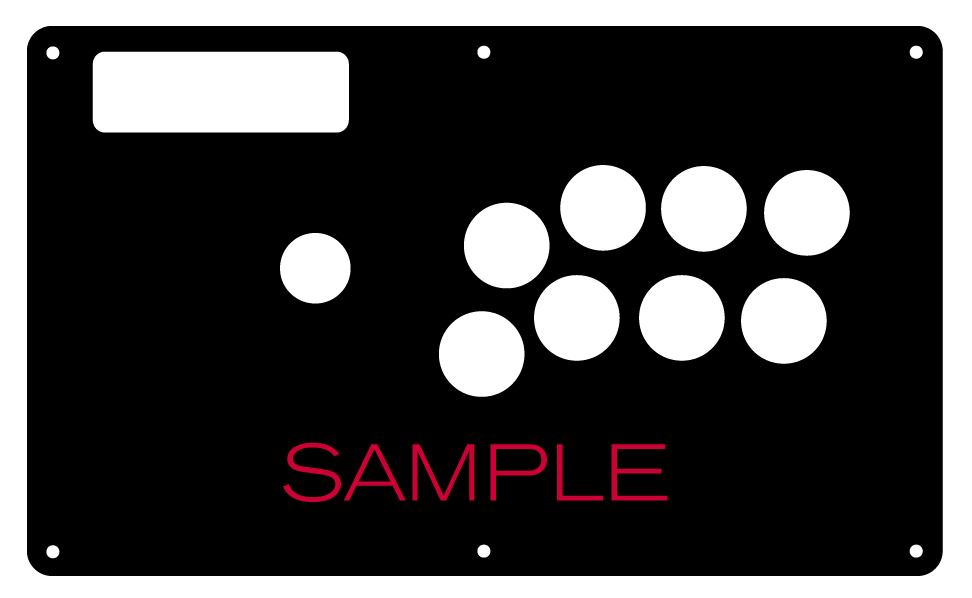
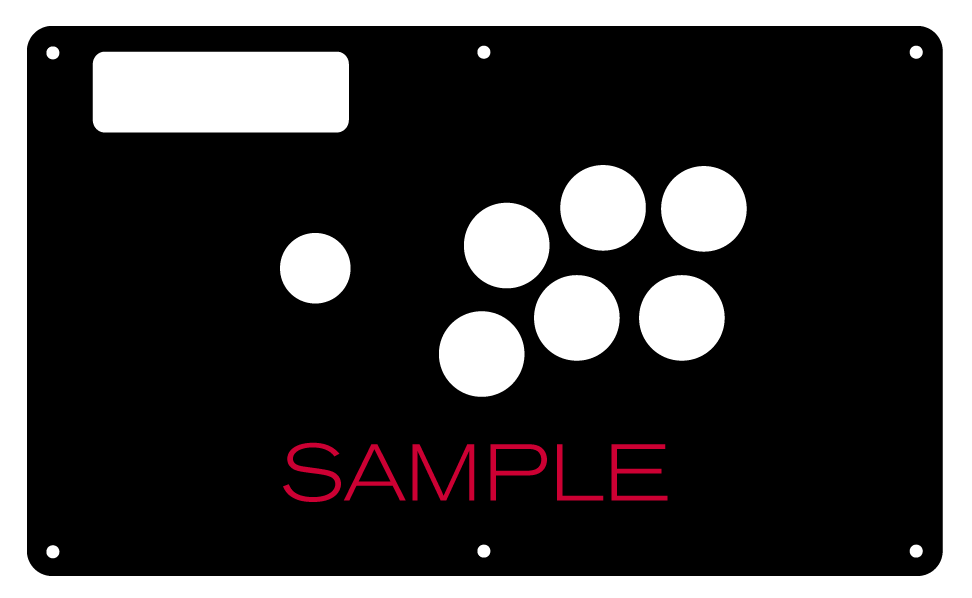
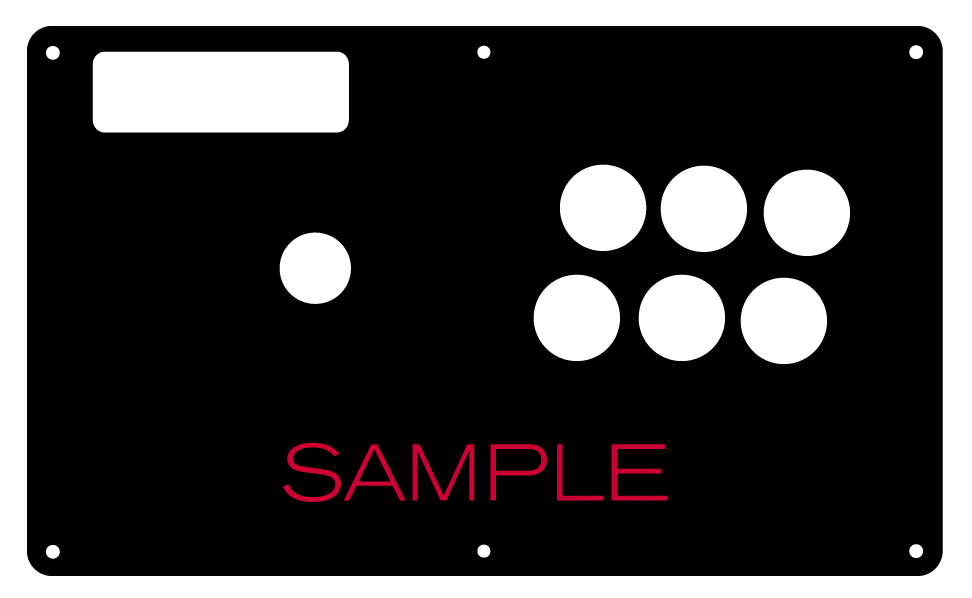
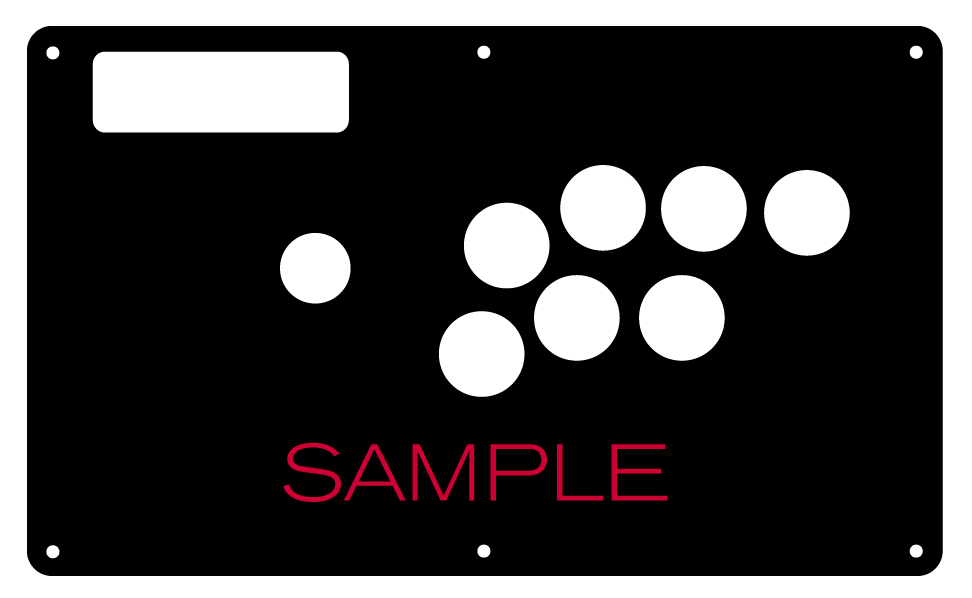 8 Button VewlixFirst 6 ButtonsLast 6 Buttons7 Button Vewlix
8 Button VewlixFirst 6 ButtonsLast 6 Buttons7 Button Vewlix
Removing Default Elements
Some Fightsticks, such as the popular MadCatz TE, offer additional personalization options by removing default elements such as control panel, start button, or screws. Cut options are defaulted to their authentic counterpart, displayed as [YES (default)] in the options list. For example, a MadCatz TE, the default configuration is to have the turbo/guide portion of the control panel cut, so that the control panel can fit properly. You have the option to select [NO] to prevent cutting these areas.
![Cut Control Panel? [NO]](http://support.focusattack.com/attachments/token/ioB7e1jzIXfxKdM8KJPKKzvKD/?name=sample-8button-noturbo.png)
![Cut Start Buttons [NO]](http://support.focusattack.com/attachments/token/SWbsx5sVHYupnBQ5iuZH1S2HK/?name=sample-nostart.png)
![Cut Middle and/or Bottom Screws? [NO]](http://support.focusattack.com/attachments/token/QzFj5pc5cNNHkOKrzlEMcc0I4/?name=sample-8button-nomiddlescrew.png) Cut Control Panel? [NO]Cut Start Button? [NO]Cut Middle and/or Bottom Screws? [NO]
Cut Control Panel? [NO]Cut Start Button? [NO]Cut Middle and/or Bottom Screws? [NO]
Cut Control Panel? [NO] - If you own a MadCatz TE, and installed a PS360+, you may no longer need the Turbo/Guide area of the control panel, located at top left. This option allows you to remove the Turbo/Guide portion. Please note that you MUST remove the actual control panel on the TE by unscrewing it before applying the plexi, or you risk damaging the plexi. Also, please make certain to select this option if you are also choosing to have artwork printed, or the plexi and artwork won't match.
Cut Start Button? [NO] - On some joysticks - such as the Qanba Q4 - the start button is directly on the panel. You can select to have this removed. You can also select this should you desire a panel similar to the Eightarc Fusion or Synthesis series Fightstick, as the start button is moved elsewhere. Again, this option is available on specific joysticks.
Cut Middle and/or Bottom Screws? [NO] - Selecting "no" on this option allows you to remove the middle top and bottom screw holes on specific joysticks, either for a cleaner appearance or to avoid rubbing your wrist against the screw. Please reconsider this option if you intend to have a full panel etch on your plexi, as etching physically changes portions of the plexi due to heat. In this case, it is best to leave the screw holes in place in order to keep the panel securely positioned.
Cut Button Inserts

Pushbutton manufacturers such as Sanwa, Seimitsu, Crown and GamerFinger have each produced specific models with a clear or translucent plastic cap and flat plunger. These are often used to display a graphical insert, allowing you to enhance the button's appearance. That said, each button manufacturer has designed the artwork cap with a different diameter than their competitors. For example, GamerFinger's artwork cap has a diameter that is slightly larger than Seimitsu or Sanwa. An insert cut for a Sanwa artwork cap will fit loosely when inserted into the GamerFinger artwork cap. This is an undesirable result that can produce a white or colored ring around the insert.
Now, you can choose the button insert cut to match the pushbutton you intend to use. This allows the insert to fit snugly within the cap.
Brands and Model with Artwork Caps
- Sanwa - OBSC (30mm) | OBSC (24mm)
- Seimitsu - PS-14-GN-C (30mm) | PS-14-DN-C (24mm) | PS-14-K (30mm) | PS-14-KN (30mm) | PS-14-DN-K (24mm)
- Seimitsu - ALUTIMO SSPS MX 24mm and 30mm
- Crown - SDB-201-C, SDB-202 MX (30mm) | SDB-202-MX (24mm)
- Qanba - GRAVITY 24 and 30mm
- GamerFinger - HBFS30 (30mm) |HBFS24 (24mm)
In some instances, a button brand or model does not have a 24mm equivalent with art cap. In this case, we will cut to the default size of Sanwa 24mm insert.Please note that if you later intend to purchase a different button, you may need to get new button inserts or new artwork. If you are uncertain which button you may choose, Sanwa is chosen by default.
Button Cut for Qanba Q2 Glow
 Qanba Crystal and Q2 Glow feature buttons manufactured by Qanba. These buttons have a smaller cap diameter, and thus require a smaller artwork insert. If you plan to keep the Qanba Crystal or Q2 Glow buttons installed when updating your artwork, please choose the option "Crystal/Q2 Glow".
Qanba Crystal and Q2 Glow feature buttons manufactured by Qanba. These buttons have a smaller cap diameter, and thus require a smaller artwork insert. If you plan to keep the Qanba Crystal or Q2 Glow buttons installed when updating your artwork, please choose the option "Crystal/Q2 Glow".24 vs 30mm
When processing orders, a frequent mistake we found among new players is choosing the wrong size for action buttons, such as punch and kick.
Within the fighting game genre, Japanese arcade buttons commonly consist of two diameter sizes: 24 millimeter and 30 milllimeter (mm). In most configurations, 30mm represents your action button. These are front facing, appearing most prominent on your Fightstick control panel. Option button, such as "Start", "Select", or more recently "Option", "Touch", or "Share" are usually 24mm.
UPDATE: Owners of Neo Geo AES Joysticks will need 24mm pushbuttons instead of 30mm (Thanks SRK's DEZALB)
Below is a visual representation of a common Fightstick control panel. Throughout this article, we will mark 24mm in green, and 30mm in Orange.
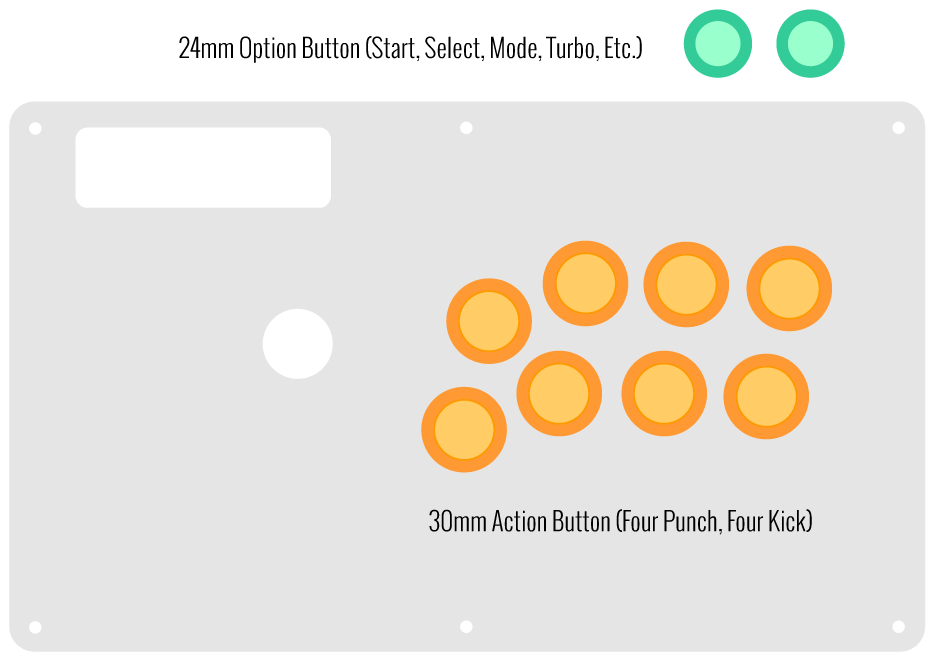
Checking the Proper Size
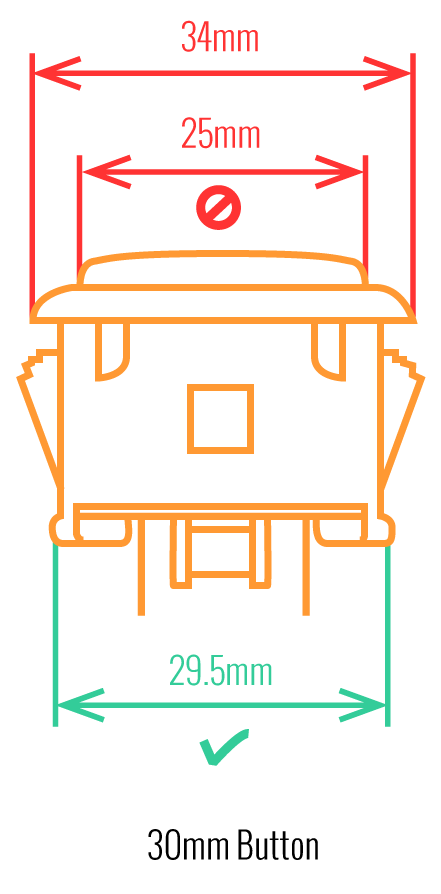 Another way that players can misinterpret the pushbutton size is by measuring the pushbutton plunger. Have a look at the diagram at right.
Another way that players can misinterpret the pushbutton size is by measuring the pushbutton plunger. Have a look at the diagram at right.The plunger - the part that you press down to represent an input - is 25mm or a bit smaller in most 30mm pushbuttons. Often this leads to the conclusion that one needs a 24mm button and not 30mm.
Similarly measuring the button rim can lead to confusion, as it is intentionally larger than the button hole it is placed in. You don't want to use these measurements. Instead, review the button housing diameter, or the hole the button will be placed in. You can do this with a caliper - a digital caliper is often quite helpful for this and other arcade-related projects.
Control Panel Configuration
Most Fightsticks from MadCatz, Hori, Qanba, and similar will use these two sizes. How the buttons are used will depend on the model joystick that you own. Over time, we'll provide example configurations for specific popular Fightstick models and arcade cabinets using the color key for 24mm (green) and 30mm (orange). We'll also expand the key for future models if another size is introduced, and we offer for sale.
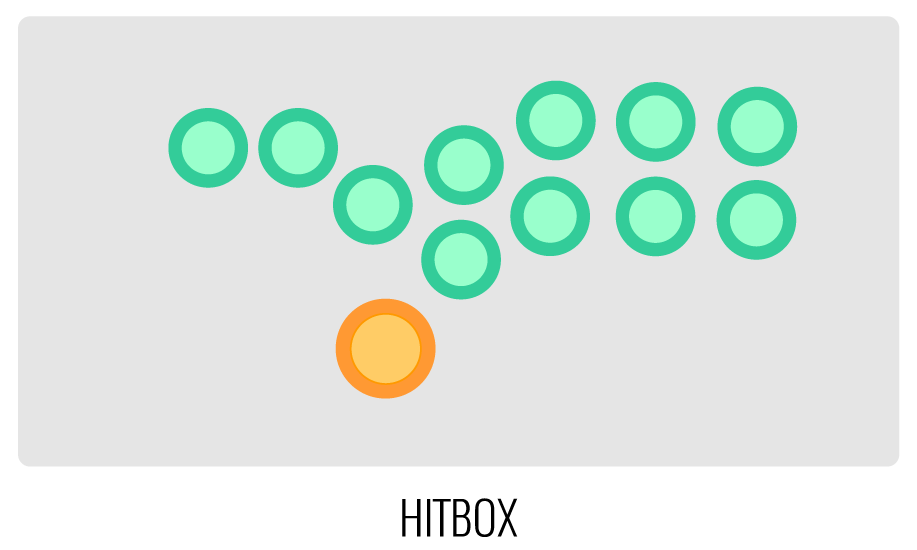
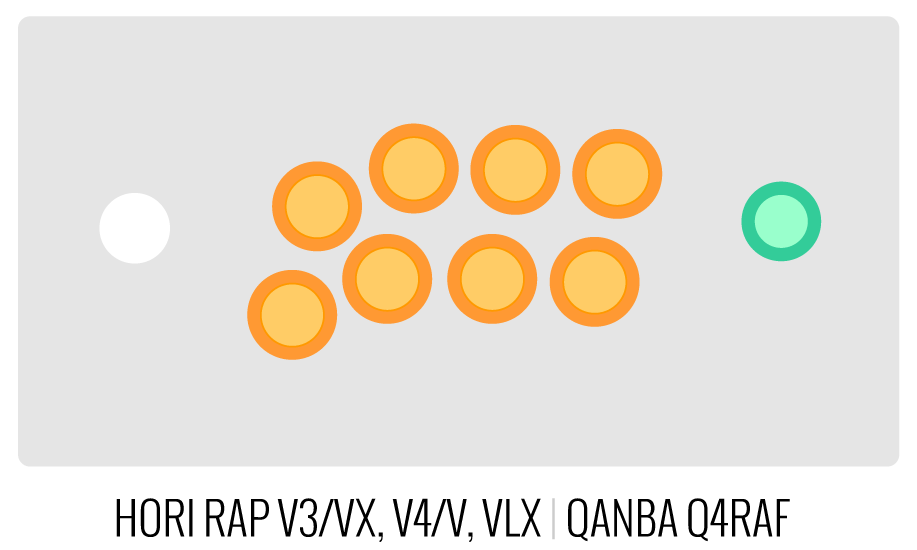
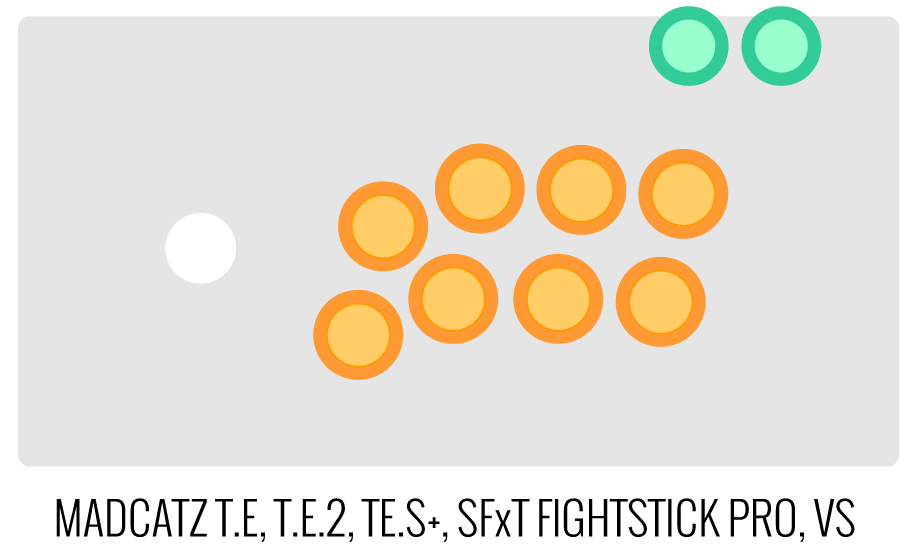
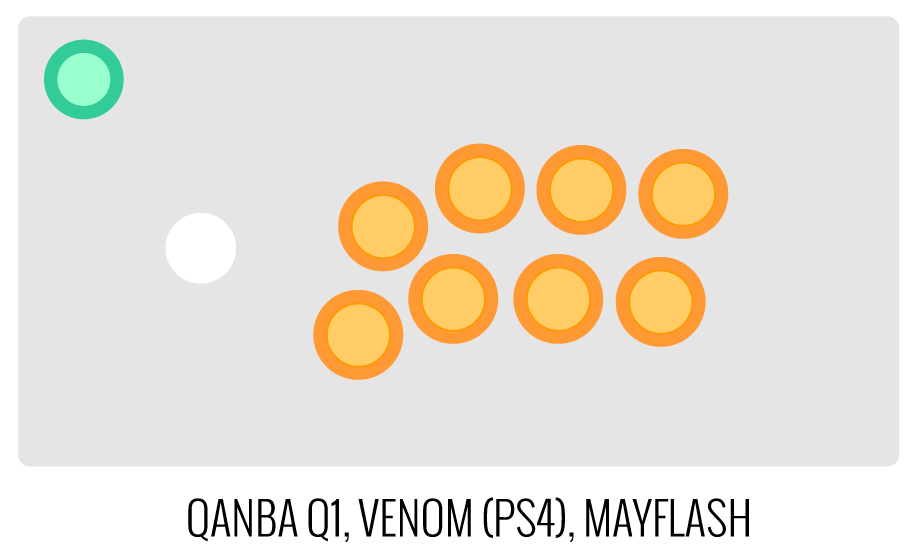
Image Edit If you would like to use a free, online Photoshop-like app to check out whether your artwork will work with a layout we offer, I highly recommend Photopea
 This amazing app works with our PSD templates and is a great way to preview your artwork or create new art files. It also exports to PSD, which is the format we recommend for submitting artwork.
This amazing app works with our PSD templates and is a great way to preview your artwork or create new art files. It also exports to PSD, which is the format we recommend for submitting artwork.Support New to FA Plexworks?
Click the "Options" tab for a detailed explanation of each customization option available to you. Using a mobile device? Click here to scroll to the descriptions.
Artwork templates
We offer a photoshop template for each custom artwork or custom plexi etch. Click the "Description" tab (or scroll up if on mobile device) to display the template and download. You can also click here to access our repository and download artwork and etch templates (in Photoshop PSD format) for your desired model and others.
Important: Using templates outside of the ones we provide may produce unwanted output. We are not responsible for output generated from unsupported templates. More information here.
Warranty and Support for FA Plexworks Custom Order
Custom orders cannot be returned for refund, or exchanged for another custom order. Orders damaged upon arrival are subject to special terms within our return policy. Please see our FA Plexworks FAQ for more information about our Plexworks return policy and related Q&A.
If you have not used our Plexworks custom services before, we recommend that you visit our support section for updated information, helpful tips, and resources to get the best output.
Some useful sections to review before making your purchase (will open in new browser window or tab):
- Learn about our Custom Job Tracker to keep tabs on your custom order while staff processes it from start to finish.
- Save time getting answers by visiting our FAQ.
- Learn more about the personalization options available to you.
- Hire a skilled artist from the Fightstick Artists Network to visualize your idea.
- Handling the artwork yourself? Review our requirements and get tips to optimize your laser etch or artwork submission.
- Learn about additional products and services we offer under FA Plexworks.
-
Product Reviews
-
Everything you need
Has everything you need to convert the obsidian 2 into a leverless and a really simple to understand guide to help you do it. The only nitpick that i have is it would've been nice to have some zip ties in the bundle to help with cable management but that's more on me for forgetting to buy some elsewhere. No complaints with the plexi, plate or art. Everything fit perfectly Unknown on Feb 19th 2025
-
-
Product Videos
-
 FA Plexworks Custom Fightstick Artwork ServicesThis video explains the many options available to you when cho...
FA Plexworks Custom Fightstick Artwork ServicesThis video explains the many options available to you when cho...
FA Plexworks Custom Fightstick Artwork Services
This video explains the many options available to you when choosing custom FA Plexworks services at focusattack.com. We also cover important tips and references for properly uploading artwork when placing an order. Visit https://www.focusattack.com/customize/ to place an order for custom Fightstick artwork, a replacement acrylic top, or even laser etched design on acrylic. For additional information about FA Plexworks, download templates, and additional tips on how to submit artwork, visit our support portal http://bit.ly/fa-plexworks-support Big thanks to Naota for his pro-tier production! ** Artwork pictures are sample illustrations. All printed artwork is submitted by the user, and not sold directly on the website. -
-
Find Similar Products by Category















